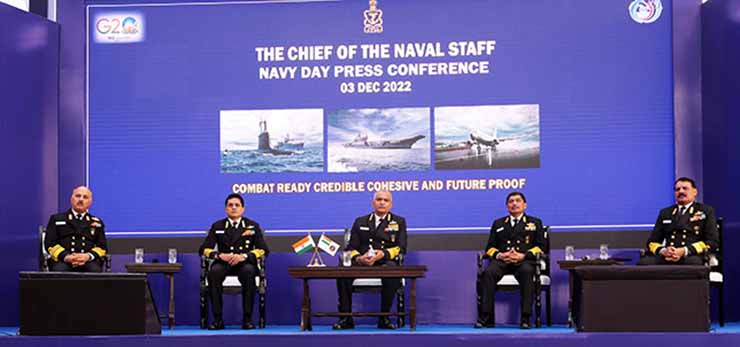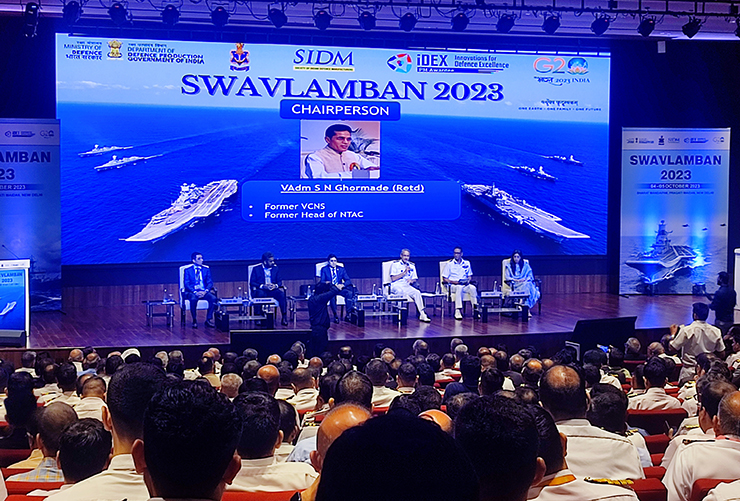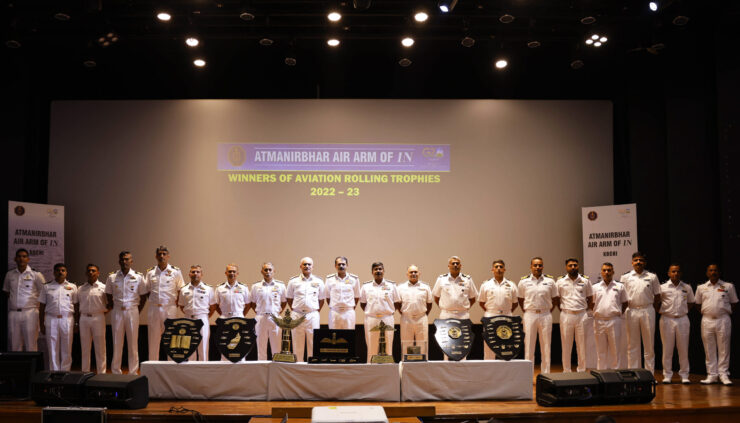
Navy Day celebrations this year will be held at the iconic Sindhudurg Fort off the Maharashtra coast, built by Maratha ruler Chhatrapati Shivaji Maharaj in the 17th century. This is in continuance of the tri-services’ new tradition of holding their flagship ceremonial events outside the national capital.
Last year, Navy Day was observed at Visakhapatnam for the first time outside of New Delhi. In addition, the Indian Army and Indian Air Force had their yearly parades in Bengaluru and Chandigarh, respectively. This year’s Air Force Day parade will take place at Prayagraj, Uttar Pradesh.
One might wonder as to why the Indian Navy is celebrating its 52nd annual day when the Indian republic will be 76 years young this year. The reason to this is that the Navy Day is celebrated to commemorate the Operation Trident, which was the attack on the Karachi harbour during the Indo-Pakistan war (on December 4, 1971) by the Indian Naval missile boats as well in to reverence all the martyrs of that war.
As a blue-water navy, Indian Navy operates significantly in the Persian Gulf Region, the Horn of Africa, the Strait of Malacca, and routinely conducts anti-piracy operations and partners with other navies in the region. It also conducts routine two to three month-long deployments in the South and East China seas as well as in the western Mediterranean Sea simultaneously.
The primary objective of the Indian Navy is to safeguard the nation’s maritime borders, and in conjunction with other Armed Forces of the union, act to deter or defeat any threats or aggression against the territory, people or maritime interests of India, both in war and peace. Through joint exercises, goodwill visits and humanitarian missions, including disaster relief, the Indian Navy promotes bilateral relations between nations.
As a blue-water navy, Indian Navy operates significantly in the Persian Gulf Region, the Horn of Africa, the Strait of Malacca, and routinely conducts anti-piracy operations and partners with other navies in the region
Currently the Indian Navy possesses a fleet of 150 ships and submarines, and 300 aircraft. As of September 2022, the operational fleet consisted of 2 active aircraft carriers and 1 amphibious transport dock, 8 landing ship tanks, 11 destroyers, 13 frigates, 2 ballistic missile submarines, 16 conventionally-powered attack submarines, 18 corvettes, one mine countermeasure vessel, 4 fleet tankers and numerous other auxiliary vessels, small patrol boats and sophisticated ships. That’s why the Indian Navy is considered as a multi-regional power projected blue-water navy.
Last year, Prime Minister Narendra Modi unveiled the navy’s new ensign at the commissioning ceremony of aircraft carrier INS Vikrant, with the flag drawing inspiration from the seal of the Maratha King Shivaji, dropping the Cross of St George. The Prime Minister called it ‘getting rid of the burden of a colonial past’.
Before that, on March 6, Union Defence Minister Rajnath Singh addressed the inaugural session of a top navy meeting aboard India’s first indigenous aircraft carrier INS Vikrant, a move bringing into greater focus the country’s efforts towards achieving self-reliance in the defence-manufacturing sector.

Navy to be fully Aatmanirbhar by 2047
The Indian Navy has made an unequivocal commitment to be fully Aatmanirbhar by 2047 when India will be celebrating 100th year of its independence
The Indian Navy, which saw the induction of indigenously built Aircraft Carrier Vikrant, in 2022, made India proud by getting it a seat at the high table of nations designing and building a warship of the size of 45,000 tonnes. Keeping in tune with PM Modi’s Aatmanirbhar Bharat Mission, the Indian Navy has pioneered indigenisation in Indian armed forces is now committed to make the country fully self-reliant by the year 2047.
This decision will be a big boost to the Indian shipyards, whose order books are already full, with a waiting period. Though India presently lacks the indigenous design and build capacity of diesel submarines, the Indian naval designers have the potential to do so, as aptly shown to the world, by its capability to manufacture nuclear powered submarine Arihant indigenously.
Indian Navy Day: Key Facts
- A celebration is held every December 4 to recognise the role and achievements of the Indian Navy, and to commemorate the start of Operation Trident against Pakistan, which ended the Indo-Pakistan war and in which for the first time anti-ship missiles were used
- Navy Day also honours the naval force’s splendour, outstanding achievements, and its importance to the nation
- The Maratha Emperor, Chhatrapati Shivaji Maharaj, is regarded as the Father of the Indian Navy
- The Navy operates above, over, and below the ocean surface to protect our national interests. It also has the objective of maintaining and improving peaceful situation within the Indian Ocean Zone
- Currently, Indian Navy employs 67,252 active personnel, in addition to 75,000 reserve personnel
- Indian navy commands 295 ships including auxiliaries. In addition, Indian Navy also operates approx. 300 aircraft
“Maintaining credible deterrence, while remaining ready to go into harm’s way to protect, preserve and promote our national interests will remain our principal priority,” stated Admiral R. Hari Kumar, Chief of the Naval Staff at the Navy Day function last year.
Indirectly conveying a message to rival maritime forces, the Navy Chief said, “First and foremost, maintaining credible deterrence, while remaining ready to go into harm’s way to protect, preserve and promote our national interests will remain our principal priority. Our vision of being a combat ready, cohesive and future-proof force underpins this aspect.”
“As recent global events have amply underscored, this vision cannot be met in letter and spirit if we remain dependent on others for our security needs. To that end, the government has clearly spelt out the need for Aatmanirbharta. The Indian Navy, on our part, has made an unequivocal commitment to be fully Aatmanirbhar by 2047.”
Further explaining the rationale of Aatmanirbharta, the Naval Chief declared that the Navy plans to have unmanned, and autonomous capabilities in future – be it in air, over surface or underwater. This will significantly augment the Indian Navy’s capability to help tackle the threats in Indian waters more precisely and effectively.
Keeping in tune with PM Modi’s Aatmanirbhar Bharat Mission, the Indian Navy has pioneered indigenisation in Indian armed forces is now committed to make the country fully self-reliant by the year 2047
According to the Navy Chief, the combat readiness of the forces and budgetary provisions are now increasingly being looked at jointly by the three Services. The Navy Chief committed Indian Navy to jointness and increased synergy and collective efforts.
With India’s growth as regional power and a booming economy, it’s maritime interests and investments will also expand proportionately which in turn will mandate expansion in the Indian Navy’s responsibilities and operational footprint to protect these interests. In furthering and strengthening these vital goals, the Indian Navy will remain diligent in pursuit of building bonds of friendship and operational cohesion with like-minded nations across the Indo-Pacific and beyond.
To keep round the clock vigil on maritime activities of inimical forces, the Naval Chief revealed that presently the Indian Navy keeps close watch on Chinese surveillance and fishing ships and elaborated on National Domain Awareness Project (NMDA), which will be an integrated intelligence grid to detect and thwart threats emanating from sea in real time.
Navy Chief also revealed that procurement decision to acquire armed MQ-9B Predator (Sea Guardian Drones) from the U.S. is under process Earlier last month, Indian Navy hosted a two day seminar, themed ‘Aatmanirbhar Air Arm of the Indian Navy 2023′, from November 13-14, 2023. The event was organised under the aegis of HQ Naval Aviation.
In an indirectly message to rival maritime forces, the Navy Chief said that its role is first and foremost, to maintain credible deterrence, while remaining ready to go into harm’s way to protect, preserve and promote our national interests remains navy’s principal priority
In his keynote address at a seminar organised by the Southern Naval Command, Kochi on November 13, the CNS emphasised the need for a self-reliant approach to meet the challenges in the maritime domain. He stated that the current strides taken towards the localisation of various spares and critical components towards aircraft manufacturing within the country has gathered pace and the potential of the Indian industry has been encouraging. He highlighted the importance of flight safety and reduction of aircraft accidents by enforcing stringent checks and revisiting the SOPs.

The Indian Navy has been focusing on developing indigenous platforms, systems, sensors and weapons as part of the nation’s modernisation and expansion of its maritime forces. As of now, the Indian Navy has 45 vessels of various types under construction, including destroyers; frigates; corvettes; conventional-powered and nuclear-powered submarines and various other ships, and plans to build a strong navy of 200 vessels and 500 aircraft by 2050. In essence, India has transformed from a buyer’s navy to a builder’s navy.
The increasing interest of the Chinese People’s Liberation Army Navy in the Indian Ocean region has also led the Indian Navy to invest more in anti-submarine ships, such as the Kamorta-class corvette, long-range maritime reconnaissance aircraft such as Boeing P-8 Poseidon and ships such as the Saryu-class patrol vessel and unmanned aerial vehicles such as the IAI Heron-1. However the lack of a strong submarine fleet has diminished its capabilities to some extent.
It has been announced that the Indian Navy plans to upgrade the military facilities in the Andaman and Nicobar Islands on the eastern seaboard as well as Lakshadweep on the western seaboard, with the aim of having a network of island airbases in both the Arabian Sea and the Bay of Bengal
Indian Navy’s Priorities
Post-Chinese intrusions in Ladakh in 2020, it has been announced that the Indian Navy plans to upgrade the military facilities in the Andaman and Nicobar Islands on the eastern seaboard as well as Lakshadweep on the western seaboard, with the aim of having a network of island airbases in both the Arabian Sea and the Bay of Bengal to build an infrastructure which will guarantee freedom of navigation and over flight to all Indian territories.
In March 2023 in a huge boost to achieve Aatmanirbharta in defence, Ministry of Defence, signed contracts with Indian shipyards for acquisition of 11 Next Generation Offshore Patrol Vessels and six Next Generation Missile Vessels at an overall cost of approx. Rs 19,600 crore.
The contract for acquisition of 11 Next Generation Offshore Patrol Vessels under Buy (Indian-IDDM) category was signed with Goa Shipyard Ltd (GSL) and Garden Reach Shipbuilders and Engineers (GRSE), Kolkata at a total cost of Rs 9,781 crore. Of the 11 ships, seven will be indigenously designed, developed & manufactured by GSL and four by GRSE. The delivery of the ships is scheduled to commence from September 2026.
The acquisition of these ships will enable the Indian Navy to maintain its combat capability and meet various operational requirements such as Anti-Piracy, Counter-Infiltration, Anti-Poaching, Anti-Trafficking, Non-Combatant Evacuation Operations, Search and Rescue (SAR), Protection of Offshore Assets etc.
Another contract for acquisition of six Next Generation Missile Vessels (NGMV) at a cost of Rs 9,805 crore was signed with Cochin Shipyard Limited (CSL). The delivery of ships is scheduled to commence from March 2027. The NGMVs would be heavily armed war vessels incorporating stealth, high speed and offensive capability. The primary role of the ships would be to provide offensive capability against enemy warship, merchantmen and land targets.
These ships will be capable of conducting Maritime Strike Operations, Anti-Surface Warfare Operations and would be a potent instrument of sea denial for enemy ships especially at choke points. In defensive role, these ships would be employed for Local Naval Defence operations and seaward defence of Offshore Development Area. The construction of these ships will generate an employment of 45 lakh man-days over a period of nine years.
The indigenous manufacturing of these vessels will encourage the active participation of Indian shipbuilding and associated industries, including MSMEs. With the majority of the equipment and systems sourced from indigenous manufacturers, these vessels will be a proud flag bearer of Aatmanirbhar Bharat.
The Indian Navy has commissioned the building of its second aircraft carrier named IAC-2 by the Cochin Shipyard. In addition, to patrol the large tract of seas and oceans under its command, the Navy is in the process of acquiring 31 MQ9-B U.S.-made Predator drones and it is also evaluating the latest British-made Mojave drones
The Indian Nay sails ahead keeping in tune with times, the evolving nature of combat and patrol activities has guided it to adopt newer technologies for its arsenal. In this regard the Indian Navy has commissioned the building of its second aircraft carrier named IAC-2 by the Cochin Shipyard. Further, while the government is also actively considering requirement for a third aircraft carrier, work is already ‘underway’ in bringing the nascent imperatives to the drawing board, according to the CNS, as the centrality of the Indo-Pacific region in global geo-strategic calculus can’t be ignored and to keep pace with this, India needs at least three aircraft carriers.
To manage the large tract of seas and oceans under its command, the Navy is in the process of acquiring 31 MQ9-B U.S.-made Predator drones and it is also evaluating the latest British-made Mojave drones. Indian Navy Chief Admiral R. Hari Kumar has said that India is evaluating them and may even work with them Royal Navy) hinting to potential collaborating with UK to produce them indigenously, thus taking one more step towards making itself more Aatmanirbhar.
–The writer is a political commentator based in New Delhi. He can be contacted on www.asadmirza.in. The views expressed are of the writer and do not necessarily reflect the views of Raksha Anirveda















